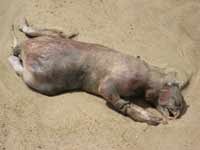Cryptozoology slowly disappears with Montauk Monster
Many mysteries of the previous century had been unraveled by the beginning of the current century. The Loch Ness Monster has been officiakky recognized dead (video, article), those who still believe in the existence of Big Foot (article and photo gallery) and Chupacabra (read articles here and here) make the minority. The term ‘cryptozoology,’ which Belgian zoologist Bernard Heuvelmans introduced at the end of the 1950s, becomes history slowly but surely.

Both common people and scientists used to be greatly interested in the existence of mysterious animals. A photograph or a video tape would always make headlines in many newspapers and provoke vivid discussions all over the globe.
In addition to widely recognized “stars” like giant apes and lake monsters, there also were sea lizards, giant squids, snake-birds and even dinosaurs.
The extensive list of cryptids – the animals, which no one has ever spotted – particularly includes the Jackalope – a hybrid of an antelope and a rabbit, the Jersey Devil – a winged creature with a long neck, as well as numerous analogues of the Loch Ness Monster – the Mokele Mbembe reptile from Africa, the Champ and the Ogopoga (lake animals) from North America.
All these stories seem to be nothing more but modern fairytales. However, there is a reason, which makes official science pay attention to cryptids. Serious biologists have made quite a number of real discoveries on the base of anecdotes and folklore of residents of various countries. The list of such successes includes the discovery of gorillas in 1847 (the mountain gorilla was discovered in 1902), the giant panda in 1869, the okapi (a short-necked type of giraffe) in 1901, the giant monitor lizard, or the Komodo Dragon in 1912, the bonobo (the Pygmy Chimpanzee) in 1929, the megamouth shark in 1976 and the giant gecko in 1984.
The capture of Latimeria, or Coelacanth - the oldest living lineage of gnathostomata known to date – became an outstanding achievement of the kind in 1938. It was previously believed that the ancient fish had become extinct during the Cretaceous period.
Discoveries of previously unknown species of insects and bacteria are published in scientific magazines on a regular basis, although this does not seem to be that interesting to the general public.
A weird creature has recently been found on USA’s Montauk coast. The dead animal resembled a dog or a coyote, but had a very strange beak. The beast was soon dubbed as the Montauk Monster. US biologists, who examined the body, stated that the creature was not known to science. Newsday quoted William Wise, the director of Stony Brook University's Living Marine Resources Institute, who also tried to comment the photograph.
The scientist said that it was not:
- a raccoon (the legs are too long in proportion to the body);
- a sea turtle (sea turtles do not have teeth);
- a rodent (rodents have two big teeth in front of their mouths).
Wise also said that the shape of the weird creature’s body looked like a dog or another canine. However, its prominent eye ridges and the feet do not match, the scientist said. He also said that the feet and the face look ovine, but sheep do not have sharp teeth.
Many people said that the photograph was a fake photoshoped picture.
However, there were a number of witnesses who confirmed the presence of the strange creature on the Montauk beach.
NY Magazine published an interview with a 22-year-old woman, who personally saw the monster. The woman said that she was walking along the beach when she saw a crowd of people looking at something on the sand.
Unfortunately, the Long Island find will not result in another sensational discovery. The corpse of the animal vanished and can no longer be available to scientists. The Montauk Monster will most likely go down in history like Nessie and Big Foot did.
Biologists need to have the body of an unknown animal to make the statement of fact. If the body disappears, skepticism remains the only reasonable reaction.
Photo: gawker.com
Angelina Fedorova
Pravda.ru
Subscribe to Pravda.Ru Telegram channel, Facebook, RSS!




